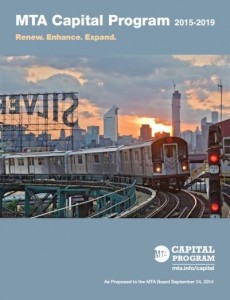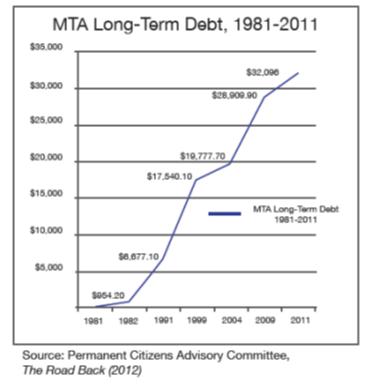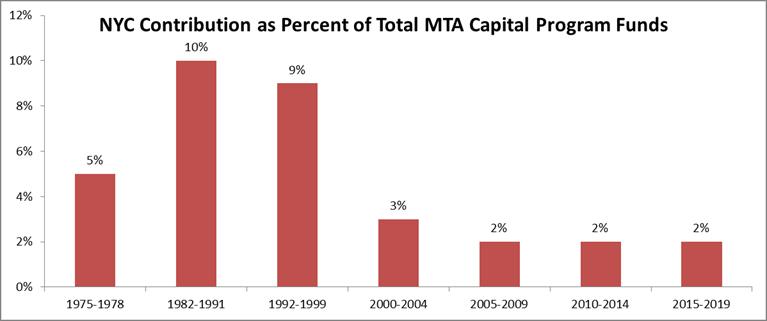 The New York Metropolitan Transportation Authority recently unveiled its proposed $32 billion 2015-2019 Capital Program, subsequently adopted by the MTA Board at today’s meeting. The proposal is made up of “vital investments” derived from the 2015-2034 Twenty Year Capital Needs Assessment that will “renew, enhance, and expand the MTA network” by “addressing evolving customer needs and expectations, while at the same time reinforcing the importance of investing to keep MTA safe and reliable.”
The New York Metropolitan Transportation Authority recently unveiled its proposed $32 billion 2015-2019 Capital Program, subsequently adopted by the MTA Board at today’s meeting. The proposal is made up of “vital investments” derived from the 2015-2034 Twenty Year Capital Needs Assessment that will “renew, enhance, and expand the MTA network” by “addressing evolving customer needs and expectations, while at the same time reinforcing the importance of investing to keep MTA safe and reliable.”
A significant portion of the proposed plan is dedicated to the completion of large-scale transportation infrastructure projects, including the LIRR Ronkonkoma branch Double Track project, the Metro-North Harmon Shop replacement project, East Side Access and the expansion of the Metro-North New Haven Line to Penn Station. Each of these projects has its own major implications for regional transportation service. For the proposed 2015-2019 Capital Plan to include so many major capital investments sets the stakes a lot higher for this program being approved, and being fully funded.
In addition to high-profile network expansion projects like the LIRR double track and the Second Avenue Subway, the Capital Program also calls for spending $30 million on equipment to expand Select Bus Service along key routes in partnership with the NYC Department of Transportation.
Of particular interest in the Capital Program is the reconstruction of the Henry Hudson toll plaza to fully and permanently implement cashless open road tolling along the bridge. The pilot program, supported by Tri-State, was widely applauded, but in order for the program to expand successfully, toll evasion legislation is needed.
These projects aside, safety and reliability are the true focus of the Capital Program, with $22 billion of the $32 billion plan slated for new rail cars, ferries and buses and state of good repair investments for the network’s seven bridges and two tunnels, as well as viaducts and rail line structures.
 Unfortunately, as it proposes these reliability projects, the agency is also proposing a Capital Program with the largest funding gap in MTA history – nearly 50 percent of the $32 billion plan is currently unfunded. The current financial situation is as unreliable as ever – federal funding constitutes 20 percent of the Capital Plan program costs, but Congress has yet to advance a multi-year bill to replace MAP-21 (which was extended through May 2015). The MTA Capital Program has attempted to account for this uncertainty in its funding assumptions.
Unfortunately, as it proposes these reliability projects, the agency is also proposing a Capital Program with the largest funding gap in MTA history – nearly 50 percent of the $32 billion plan is currently unfunded. The current financial situation is as unreliable as ever – federal funding constitutes 20 percent of the Capital Plan program costs, but Congress has yet to advance a multi-year bill to replace MAP-21 (which was extended through May 2015). The MTA Capital Program has attempted to account for this uncertainty in its funding assumptions.
As government contributions have declined in recent years, the MTA has had to take on greater debt to fund its capital projects. Borrowing accounts for another nearly 20 percent of the Capital Program’s currently projected funding. The increasing debt and detrimental funding gap have led to some creative funding strategies, such as moving the agency’s payroll tax from operating costs to its capital budget as a means of stabilizing some funding as well as reducing interest rates. This puts added pressure on fares and service levels in the event that these gaps are not filled.
Meanwhile, New York City’s annual contribution to the MTA’s Capital Plan remains a pittance. The City provided as much as 10 percent of total Capital Funds in the 1980s, but the City’s contribution dropped significantly to 3 percent in the 2000-2004 Capital Program, and further to just 2 percent in the following Program, where it remains in this draft.

The MTA plays a vital role in the day-to-day lives of New Yorkers and is the lifeblood of the region’s economy. Steadily increasing ridership and annual passenger miles and trips show growing reliance on and preference for the MTA’s network, and the Capital Program’s network expansion projects coupled with Mayor de Blasio’s push for transit-oriented development in his Affordable Housing Plan only guarantee greater usage in the near future.
Tri-State, in the week ahead, will be analyzing the Capital Programs for the LIRR, Metro-North and NYCT in more depth, but one thing is certain: the New York region, and the United States’ economy, depend upon a robust transit network in the metropolitan region. A fully-funded, five-year MTA Capital Plan is needed to ensure the state of good repair of the system and to meet the challenges of increased ridership, climate change and maintaining economic competitiveness.
This in turn will require new revenue. While a number of options exist to ensure our region’s transportation systems have the resources they need, the best option available to provide sufficient recurrent revenue for the MTA Capital Plan is the MoveNY plan. The MoveNY plan will also decrease reliance upon debt, fare increases and service cuts; reduce traffic congestion; improve regional air quality; enhance economic growth; and redress inequity in NYC’s tolling network.
It is now up to Governor Cuomo, Mayor de Blasio and the New York State Legislature to find the funding necessary to make this plan whole.

[…] Without Funding Fix, MTA Capital Program Is Debt Bomb for Riders (NYT, WSJ, Crain’s, MTR) […]
If you are going to take seriously the idea that if $15 billion is borrowed a disaster will occur, then you also have to accept the reality that a disaster has already occurred, and those who benefitted from it have gotten away with it. Thus the fact that THEY don’t think another $15 billion is a problem.
Put it on context, and it is one part of a much larger story. The story is Generation Greed. Until they are made to at least pay a psychological price in public scorn, the current trends will continue to the final institutional collapse.
http://larrylittlefield.wordpress.com/2014/08/10/generational-equity-and-the-legacy-of-todays-politicians-update/
[…] than 275,000 daily commuters on Metro-North received good news in the MTA’s newly-released 2015-2019 Capital Program: the agency is moving forward with Penn Station Access, a $743 million project which has spent […]
[…] analysis coincides with the recent release of the MTA’s draft 2015-2019 Capital Program, which faces a $15.2 billion funding shortfall. The shortfall is a serious threat to capital […]
[…] Zee Bridge site and dodging more questions about how the project is to be funded, Cuomo called the MTA’s proposed 2015-2019 Capital Program […]
[…] Long Island. It is also the nation’s oldest commuter rail system, and as such, the MTA’s proposed 2015-2019 Capital Program allocates nearly 10 percent of total expenditures to the system with a focus on better […]
[…] greater investment — MTA Chairman Tom Prendergast says the $15.2 billion funding gap in the MTA’s proposed capital plan is “unconscionable,” but the governor says it’s just “bloated.” A first-ever […]
[…] “The governor, the legislature, and the mayor must do the heavy political lifting to find new revenue sources to fund a $15 billion gap in the […]
[…] and harden against catastrophes like Hurricane Sandy. Considering that a whopping $22 billion of the MTA’s proposed $32 billion 2015-2019 Capital Program is slated for new rail cars, ferries and buses and state of good repair investments for the […]
[…] Transit ridership across New York is at an all-time high, yet Albany’s investment is not rising to the occasion—the proposed 2015-2016 Executive Budget keeps operating assistance flat at 2014-2015 levels for all non-MTA transit systems. The advocates and electeds called for more than $140 million in new operating aid investment for non-MTA transportation systems, and also called for a fully-funded MTA Capital Program. […]
[…] failure to invest in infrastructure is holding us back.” Does this mean there will be an increase in city funding to the MTA’s capital plan to match the call for increased federal […]
[…] were some wins for upstate transit, but the biggest punt for future negotiations was how to fund the MTA’s 5-year capital program. (Hat tip to New York Public Transit Association for this very helpful summary of transit in the […]
[…] Transportation Authority — The issue of how to address the MTA’s budget gap was left unaddressed in Albany’s final budget negotiations, and, adding insult to […]
[…] And across the river in New York, where 75 percent of the NYC metro region’s total population and 90 percent of its working population use mass transit and ridership is skyrocketing, dedicated bus lanes are considered a “lack of respect” to drivers, and elected officials continue to divert mass transit funding and decry attempts to toll river crossings in the face of $33 billion in unfunded mass transit capital needs. […]
[…] analysis precedes the March 31 deadline for the state budget and the approval of the Metropolitan Transportation Authority’s 2015-2019 Capital Plan, which is 16 months behind schedule. Without an approved plan, scheduled LIRR […]